Global Topics
Ship & Offshore Structure Company
Integrating Operations of Sakaide Works, NACKS*1 and DACKS*2
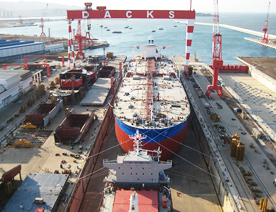
The Ship & Offshore Structure Company signed a joint venture agreement with China Ocean Shipping (Group) Company (COSCO), the largest shipping company in China, in 1995 and established NACKS in Nantong, Jiangsu Province. Kawasaki places priority on the development of human resources and not only sends technical instructors over from Japan but has also started a program through which locally hired engineers come to the Sakaide Works to learn the basics of shipbuilding technology. In 2015, NACKS celebrated its 20th anniversary and the first graduates of our training program are now at the forefront of this company in executive and senior management positions. The quality and performance of NACKS-built vessels have earned high marks from clients not only in China but also in other countries, and the company boasts technical expertise and cost-competitiveness that rival the highest standards anywhere in the world. In 2007, DACKS was established as a joint venture between COSCO and NACKS in Dalian, Liaoning Province, with outstanding engineers who developed their skills at NACKS assigned as mentors to develop human resources in cooperation with technical instructors from the Company. DACKS is also introducing the latest equipment and facilities into operations to boost efficiency.
*1 Nantong COSCO KHI Ship Engineering Co., Ltd. (NACKS)
*2 Dalian COSCO KHI Ship Engineering Co., Ltd. (DACKS)
Rolling Stock Company
Introduction and Wide Application of Kawasaki Production System (KPS)* at Overseas Facilities
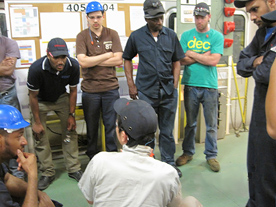
The Rolling Stock Company manufactures rolling stock at facilities in the United States as well as in Japan and has introduced KPS to elevate productivity in manufacturing high-quality rolling stock. In 2014, we initiated productivity improvement activities using KPS, at our facility in Yonkers, New York, on projects that were in progress at that time. Engineers were sent over from Japan a number of times, working alongside local employees to establish a better environment for operations, create the right framework for activities and pursue improvements in operations on various fronts. Language and cultural differences presented a few hurdles, but meetings, characterized by a repeated process of honest discussion, along with improvements by local employees and support from Japanese engineers proved successful, and target values were achieved. Local employees remain committed even now to the improvement trend. The facility in Lincoln, Nebraska, has also embraced KPS and is engaged in efforts to extend the scope of KPS application through improvement activities.
Persistent approaches like these form a foundation that supports the Kawasaki brand, which enjoys a solid reputation in the U.S. railway industry.
* Kawasaki Production System (KPS) is a streamlined production control method, based on the Just-In-Time (JIT) concept, and was developed and verified by Kawasaki through application at the Company’s manufacturing sites and on facility production lines. The system can be applied to various facility/production lines, from mass-production to engineered-to-order manufacturing.
Aerospace Company
Start of Aircraft Parts Production in the United States
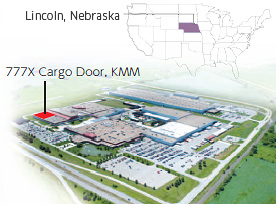
The Aerospace Company is in the process of building a new assembly line for Boeing 777X cargo doors at the KMM*1 facility in Lincoln, Nebraska. Kawasaki will maximize its experience gained over many years in producing motorcycles and rolling stock at the Lincoln facility and integrate segment technologies to realize a state-of-the-art production line. In the procurement of parts and jigs and tools, the goal is local production for local consumption, and we aim to make this facility a cornerstone for expansion into a key production base in the United States. We will aggressively promote KPS*2 here and introduce automated facilities and Kawasaki-built robots to boost productivity and keep quality levels constant. We will also focus on developing the skills of human resources with a global perspective through on-the-job training for local employees, who we will bring to the Gifu Works and the Nagoya Works for several months of hands-on instruction, while sending young employees from the Aerospace Company to local operations, to get overseas plants operating and acquire operation-related know-how.
*1 Kawasaki Motors Manufacturing Corp., U.S.A., a Kawasaki subsidiary in the United States
*2 KPS (Kawasaki Production System) is a streamlined production control method, based on the Just-In-Time (JIT) concept, and was developed and verified by Kawasaki through application at the Company’s manufacturing sites and on facility production lines. The system can be applied to various facility/production lines, from mass-production to engineered-to-order manufacturing
Gas Turbine & Machinery Company
Exporting Distributed Power Generation System Infrastructures
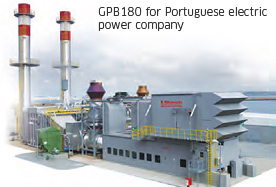
The Gas Turbine & Machinery Company develops and produces gas engines with power efficiency rated in the world’s highest class, as well as the best gas turbines for cogeneration systems, which provide both heat and electricity at the same time.
In addition to providing products with the highest efficiency rating, we help our customers boost energy efficiency and reduce environmental load from a balanced heat and power perspective through solutions emphasizing distributed energy systems ideal for the community and the customer and through access to highly efficient power generating systems.
We have built a presence at home and abroad, notably with sales and service bases in Southeast Asia, where the increase in demand for power is quite outstanding and market potential for our systems is high. Here, we present the best energy solutions for local needs.
Plant & Infrastructure Company
Utilizing KDT*
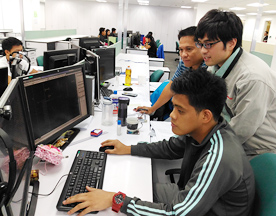
The Plant & Infrastructure Company includes KDT, an engineering subsidiary in the Philippines, which plays a vital role in cutting costs and developing the skills of young employees.
We intend to expand the scope of designs through standardization and also expand the scope of business activities, including opportunities to send KDT engineers to project sites as supervisors. We plan to raise the capabilities of KDT while cutting the cost of engineering overall and reinforce the competitiveness of our products.
On the human resources development front, we set up the KDT Training Program for Young Engineers, which gives Japanese engineers the chance to gain mastery in such business practices as controlling the status of on-site design work and coordination and negotiation with overseas cooperatives. Every quarter, six people are sent to KDT for three months, with the expectation that they will improve their individual skills by accumulating experience on many levels, from technical exchange with local engineers to executing tasks in English and gaining an appreciation of different customs and cultures. As of June 2016, we have sent 56 people to KDT, and the people who received training are now actively involved on-site in projects around the world.
* KHI Design & Technical Service Inc. is a Kawasaki subsidiary in the Philippines
Motorcycle & Engine Company
Global Business and Management
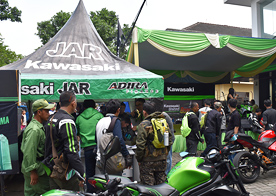
Guided by the “Kawasaki, working as one” philosophy, the Motorcycle & Engine Company is working to establish Kawasaki as a Globally Integrated Enterprise under a three-point concept highlighting One Company, One Voice (presenting a unified brand image to the world), and Number One in profitability. This focus will fuel the segment’s efforts to represent Kawasaki as a manufacturer delivering continuous growth in high-value-added domains in the power sports and general-purpose engine markets.
Demand for Kawasaki-brand products encourages growth in markets all over the world, and the Motorcycle & Engine Company is building a network of production bases and sales bases worldwide. Currently, we have 12 production and sales subsidiaries in 10 countries overseas, staffed by some 5,000 locally hired employees. About 100 people have been transferred from Japan to these local subsidiaries, and by acquiring an understanding of culture and customs in each country, they help pinpoint local needs and identify emerging business chances.
We also hold events, such as safe riding programs and seminars as well as test-ride opportunities, experience tours and races, under the sponsorship of local sales subsidiaries and dealerships. These activities exemplify the efforts we put into cultivating a young customer base that enjoys motorcycles not only from an on-the-road perspective but also from a leisure perspective as well as our enthusiasm to establish new traditions, such as motorsport, in emerging markets.
Precision Machinery Company
Integrate Precision Machinery Company Operations at KPM (Suzhou)
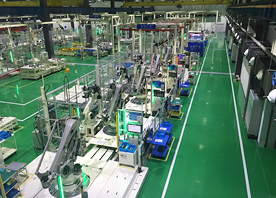
The Precision Machinery Company began investment in China by establishing Kawasaki Precision Machinery (Suzhou) Ltd., a production company in the hydraulic machinery business, in 2005, and Kawasaki Robotics (Tianjin) Co., Ltd., a sales and service company in the robotics business, in 2006. These subsidiaries were followed by KPM (Shanghai) and Kawasaki Chunhui Precision Machinery (Zhejiang) Ltd., in the hydraulic machinery business, and Kawasaki Robotics (Kunshan) Co., Ltd. and Kawasaki (Chongqing) Robotics Engineering Co., Ltd., in the industrial robots business. In June 2015, KPM (Suzhou)—the hydraulic machinery production base—began producing robots.
For the industrial robots business, KPM (Suzhou) is our first overseas base for robot production, and our goal is to create “a factory where robots make robots,” which has yet to be realized even at the Akashi Works—the Robot Division’s headquarters—in Japan. We initially believed the project might take a long time to get up and running, but by effectively utilizing our hydraulic machinery production experience, human resources, equipment and the factory site, we were able to get the new operations going very quickly.
Currently, KPM (Suzhou) is the Precision Machinery model for integrated operations—the first facility anywhere in our segment, including Japan. It has become a symbol for the demonstration of synergistic effects as a business segment comprising the Hydraulic Machinery and the Robot Division, as described in MTBP 2016.
Contact
If you need more information about our business,
please feel free to contact us.





